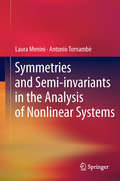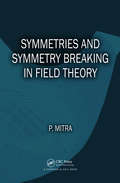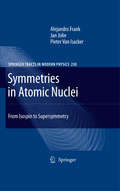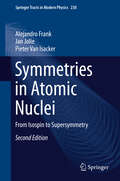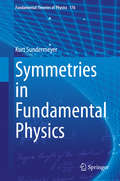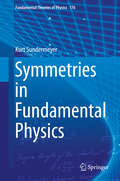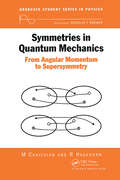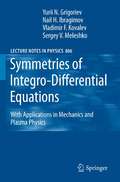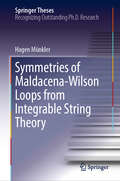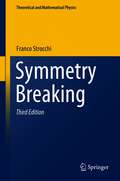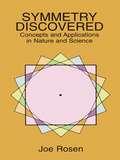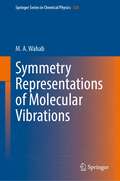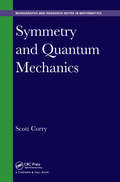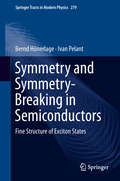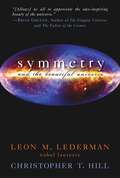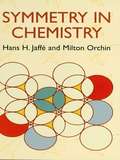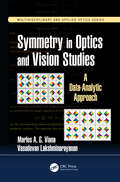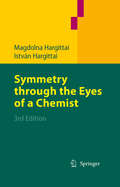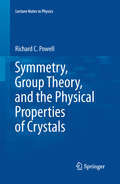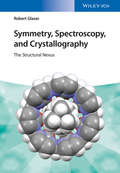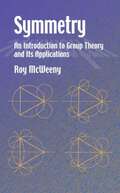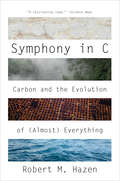- Table View
- List View
Symmetries and Semi-invariants in the Analysis of Nonlinear Systems
by Antonio Tornambè Laura MeniniThis book details the analysis of continuous- and discrete-time dynamical systems described by differential and difference equations respectively. Differential geometry provides the tools for this, such as first-integrals or orbital symmetries, together with normal forms of vector fields and of maps. A crucial point of the analysis is linearization by state immersion. The theory is developed for general nonlinear systems and specialized for the class of Hamiltonian systems. By using the strong geometric structure of Hamiltonian systems, the results proposed are stated in a different, less complex and more easily comprehensible manner. They are applied to physically motivated systems, to demonstrate how much insight into known properties is gained using these techniques. Various control systems applications of the techniques are characterized including: computation of the flow of nonlinear systems; computation of semi-invariants; computation of Lyapunov functions for stability analysis and observer design.
Symmetries and Symmetry Breaking in Field Theory
by Parthasarathi MitraMany courses on modern quantum field theory focus on the formulation and application of field theory, leaving topics related to symmetry underdeveloped. This leads to students often having an incomplete understanding of symmetries. Filling this gap, Symmetries and Symmetry Breaking in Field Theory sheds light on various aspects of symmetry in field
Symmetries in Atomic Nuclei
by Pieter Van Isacker Jan Jolie Alejandro FrankSymmetries in Atomic Nuclei aims to present an overview of recent applications of symmetry to the description of atomic nuclei. Special care is given to a pedagogical introduction of symmetry concepts using simple examples. After a historical overview of the applications of symmetry in nuclear physics, progress in the field during the last decade is reviewed. Special emphasis is put on the introduction of neutron-proton and boson-fermion degrees of freedom. Their combination leads to a supersymmetric description of pairs and quartets of nuclei. Both theoretical aspects and experimental signatures of dynamical (super)symmetries are carefully discussed. Case studies show how these symmetries are displayed by real atomic nuclei which have been studied experimentally using state-of-the art spectroscopy. This book focuses on nuclear structure physics and has been written by active investigators in the field, but its scope is wider and is intended for final-year or post-graduate students and researchers interested in understanding the power and beauty of symmetry methods in physics.
Symmetries in Atomic Nuclei: From Isospin to Supersymmetry (Springer Tracts in Modern Physics #230)
by Jan Jolie Alejandro Frank Pieter Van IsackerThe revised edition of this established work presents an extended overview of recent applications of symmetry to the description of atomic nuclei, including a pedagogical introduction to symmetry concepts using simple examples. Following a historical overview of the applications of symmetry in nuclear physics, attention turns to more recent progress in the field. Special emphasis is placed on the introduction of neutron-proton and boson-fermion degrees of freedom. Their combination leads to a supersymmetric description of pairs and quartets of nuclei. Expanded and updated throughout, the book now features separate chapters on the nuclear shell model and the interacting boson model, the former including discussion of recent results on seniority in a single-j shell. Both theoretical aspects and experimental signatures of dynamical (super)symmetries are carefully discussed. This book focuses on nuclear structure physics, but its broad scope makes it suitable for final-year or post-graduate students and researchers interested in understanding the power and beauty of symmetry methods in physics.Review of the 1st Edition:"The subject of this book, symmetries in physical systems, with particular focus on atomic nuclei, is of the utmost importance in modern physical science. In contrast to most treatments, frequently characterized by fearsome formalism, this book leads the reader step-by-step, in an easily understandable way, through this fascinating field...this book is remarkably accessible to both theorists and experimentalists. Indeed, I view it as essential reading for experimental nuclear structure physicists. This is one of the finest volumes on this subject I have ever encountered." Prof. R.F. Casten, Yale University
Symmetries in Fundamental Physics
by Kurt SundermeyerOver the course of the last century it has become clear that both elementary particle physics and relativity theories are based on the notion of symmetries. These symmetries become manifest in that the "laws of nature" are invariant under spacetime transformations and/or gauge transformations. The consequences of these symmetries were analyzed as early as in 1918 by Emmy Noether on the level of action functionals. Her work did not receive due recognition for nearly half a century, but can today be understood as a recurring theme in classical mechanics, electrodynamics and special relativity, Yang-Mills type quantum field theories, and in general relativity. As a matter of fact, as shown in this monograph, many aspects of physics can be derived solely from symmetry considerations. This substantiates the statement of E. P. Wigner ". . . if we knew all the laws of nature, or the ultimate Law of nature, the invariance properties of these laws would not furnish us new information. " Thanks to Wigner we now also understand the implications of quantum physics and symmetry considerations: Poincare invariance dictates both the characteristic properties of particles (mass, spin, . . . ) and the wave equations of spin 0, 1/2, 1, . . . objects. Further, the work of C. N. Yang and R. Mills reveals the consequences of internal symmetries as exemplified in the symmetry group of elementary particle physics. Given this pivotal role of symmetries it is thus not surprising that current research in fundamental physics is to a great degree motivated and inspired by considerations of symmetry. The treatment of symmetries in this monograph ranges from classical physics to now well-established theories of fundamental interactions, to the latest research on unified theories and quantum gravity.
Symmetries in Fundamental Physics (Fundamental Theories of Physics #176)
by Kurt SundermeyerOver the course of the last century it has become clear that both elementary particle physics and relativity theories are based on the notion of symmetries. These symmetries become manifest in that the "laws of nature" are invariant under spacetime transformations and/or gauge transformations. The consequences of these symmetries were analyzed as early as in 1918 by Emmy Noether on the level of action functionals. Her work did not receive due recognition for nearly half a century, but can today be understood as a recurring theme in classical mechanics, electrodynamics and special relativity, Yang-Mills type quantum field theories, and in general relativity. As a matter of fact, as shown in this monograph, many aspects of physics can be derived solely from symmetry considerations. This substantiates the statement of E.P.Wigner "... if we knew all the laws of nature, or the ultimate Law of nature, the invariance properties of these laws would not furnish us new information." Thanks to Wigner we now also understand the implications of quantum physics and symmetry considerations: Poincare invariance dictates both the characteristic properties of particles (mass, spin, ...) and the wave equations of spin 0, 1/2, 1, ... objects. Further, the work of C.N.Yang and R.Mills reveals the consequences of internal symmetries as exemplified in the symmetry group of elementary particle physics. Given this pivotal role of symmetries it is thus not surprising that current research in fundamental physics is to a great degree motivated and inspired by considerations of symmetry.The treatment of symmetries in this monograph ranges from classical physics to now well-established theories of fundamental interactions, to the latest research on unified theories and quantum gravity.
Symmetries in Quantum Mechanics: From Angular Momentum to Supersymmetry (PBK)
by M Chaichian R HagedornSymmetries in Quantum Mechanics: From Angular Momentum to Supersymmetry (PBK) provides a thorough, didactic exposition of the role of symmetry, particularly rotational symmetry, in quantum mechanics. The bulk of the book covers the description of rotations (geometrically and group-theoretically) and their representations, and the quantum theory of angular momentum. Later chapters introduce more advanced topics such as relativistic theory, supersymmetry, anyons, fractional spin, and statistics. With clear, in-depth explanations, the book is ideal for use as a course text for postgraduate and advanced undergraduate students in physics and those specializing in theoretical physics. It is also useful for researchers looking for an accessible introduction to this important area of quantum theory.
Symmetries of Integro-Differential Equations: With Applications in Mechanics and Plasma Physics
by N. Kh. Ibragimov Sergey V. Meleshko Yurii N. Grigoriev Vladimir F. KovalevThis book aims to coherently present applications of group analysis to integro-differential equations in an accessible way. The book will be useful to both physicists and mathematicians interested in general methods to investigate nonlinear problems using symmetries. Differential and integro-differential equations, especially nonlinear, present the most effective way for describing complex processes. Therefore, methods to obtain exact solutions of differential equations play an important role in physics, applied mathematics and mechanics. This book provides an easy to follow, but comprehensive, description of the application of group analysis to integro-differential equations. The book is primarily designed to present both fundamental theoretical and algorithmic aspects of these methods. It introduces new applications and extensions of the group analysis method. The authors have designed a flexible text for postgraduate courses spanning a variety of topics.
Symmetries of Maldacena-Wilson Loops from Integrable String Theory (Springer Theses)
by Hagen MünklerThe book discusses hidden symmetries in the Anti-de Sitter/conformal field theory (AdS/CFT) duality. This duality is a modern concept that asserts an exact duality between conformally invariant quantum field theories and string theories in higher dimensional Anti-de Sitter spaces, and in this way provides a completely new tool for the study of strongly coupled quantum field theories. In this setting, the book focuses on the Wilson loop, an important observable in four-dimensional maximally supersymmetric gauge theory. The dual string description using minimal surfaces enables a systematic study of the hidden symmetries of the loop. The book presents major findings, including the discovery of a master symmetry for strings in general symmetric spaces, its relation to the Yangian symmetry algebra and its action on the minimal surfaces appearing in the dual string description of the Wilson loop. Moreover, it clarifies why certain symmetries are not present on the gauge theory side for purely bosonic Wilson loops and, lastly, how the supersymmetrization of the minimal surface problem for type IIB superstrings can be undertaken. As such, it substantially increases our understanding and use of infinite dimensional symmetries occurring in the AdS/CFT correspondence.
Symmetries, Integrable Systems and Representations
by Sophie Morier-Genoud Kenji Iohara Bertrand RémyThis volume is the result of two international workshops; Infinite Analysis 11 - Frontier of Integrability - held at University of Tokyo, Japan in July 25th to 29th, 2011, and Symmetries, Integrable Systems and Representations held at Université Claude Bernard Lyon 1, France in December 13th to 16th, 2011. Included are research articles based on the talks presented at the workshops, latest results obtained thereafter, and some review articles. The subjects discussed range across diverse areas such as algebraic geometry, combinatorics, differential equations, integrable systems, representation theory, solvable lattice models and special functions. Through these topics, the reader will find some recent developments in the field of mathematical physics and their interactions with several other domains.
Symmetry Breaking: A Non-perturbative Outlook (Theoretical and Mathematical Physics #732)
by Franco StrocchiThe third edition of the by now classic reference on rigorous analysis of symmetry breaking in both classical and quantum field theories adds new topics of relevance, in particular the effect of dynamical Coulomb delocalization, by which boundary conditions give rise to volume effects and to energy/mass gap in the Goldstone spectrum (plasmon spectrum, Anderson superconductivity, Higgs phenomenon). The book closes with a discussion of the physical meaning of global and local gauge symmetries and their breaking, with attention to the effect of gauge group topology in QCD. From the reviews of the first edition: It is remarkable to see how much material can actually be presented in a rigorous way (incidentally, many of the results presented are due to Strocchi himself), yet this is largely ignored, the original heuristic derivations being, as a rule, more popular. - At each step he strongly emphasizes the physical meaning and motivation of the various notions introduced [...] a book that fills a conspicuous gap in the literature, and does it rather well. It could also be a good basis for a graduate course in mathematical physics. J.-P. Antoine, Physicalia 28/2, 2006 Despite many accounts in popular textbooks and a widespread belief, the phenomenon is rather subtle, requires an infinite set of degrees of freedom and an advanced mathematical setting of the system under investigation. [...] The mathematically oriented graduate student will certainly benefit from this thorough, rigorous and detailed investigation. G. Roepstorff, Zentralblatt MATH, Vol. 1075, 2006 From the reviews of the second edition: This second edition of Strocchi’s Symmetry Breaking presents a complete, generalized and highly rigorous discussion of the subject, based on a formal analysis of conditions necessary for the mechanism of spontaneous symmetry breaking to occur in classical systems, as well as in quantum systems. […] This book is specifically recommended for mathematical physicists interested in a deeper and rigorous understanding of the subject, and it should be mandatory for researchers studying the mechanism of spontaneous symmetry breaking. S. Hajjawi, Mathematical Reviews, 2008
Symmetry Discovered: Concepts and Applications in Nature and Science
by Joe RosenSymmetry provides an insight into the way nature works and is often used by scientists and technologists to help solve problems. Symmetry has numerous other applications as well -- with more being discovered all the time in science, the arts and other fields of human endeavor.This classic work provides an excellent introduction to the basic concepts and terminology (including, optionally, group theory), as well as lucid discussions of geometric symmetry, other symmetries and appropriate symmetry, symmetry in nature, uses of symmetry in science and much more.Readers wishing to pursue specific topics will find many references that reflect the author's wide reading in the subject and his own obvious enthusiasm. For this edition, Dr. Rosen has provided a new preface, solutions to the problems, and an addendum to the bibliography.
Symmetry Representations of Molecular Vibrations (Springer Series in Chemical Physics #126)
by M.A. WahabThis book presents a comprehensive theoretical basis of symmetry representations of molecular vibrations, matrix representation of symmetries, and the elements of group theory that are relevant to other symmetry elements/operations, crystallographic and molecular point groups. The book helps understand the reducible and irreducible representations of symmetry matrices and then derive the normal modes of vibration of different molecules by using suitable techniques independently. Targeted to graduate students and researchers, this book aims not only to derive the normal modes of vibration of any given molecule themselves but also compares and verifies them with the experimentally found modes by using IR and Raman-related techniques. For the first time in the crystallographic history, this book presents the group multiplication tables of all 32 point groups in both international and Schoenflies notations.
Symmetry and Quantum Mechanics (Chapman & Hall/CRC Monographs and Research Notes in Mathematics)
by Scott CorryStructured as a dialogue between a mathematician and a physicist, Symmetry and Quantum Mechanics unites the mathematical topics of this field into a compelling and physically-motivated narrative that focuses on the central role of symmetry. Aimed at advanced undergraduate and beginning graduate students in mathematics with only a minimal background in physics, this title is also useful to physicists seeking a mathematical introduction to the subject. Part I focuses on spin, and covers such topics as Lie groups and algebras, while part II offers an account of position and momentum in the context of the representation theory of the Heisenberg group, along the way providing an informal discussion of fundamental concepts from analysis such as self-adjoint operators on Hilbert space and the Stone-von Neumann Theorem. Mathematical theory is applied to physical examples such as spin-precession in a magnetic field, the harmonic oscillator, the infinite spherical well, and the hydrogen atom.
Symmetry and Symmetry-Breaking in Semiconductors: Fine Structure of Exciton States (Springer Tracts in Modern Physics #279)
by Bernd Hönerlage Ivan PelantThis book discusses group theory investigations of zincblende and wurtzite semiconductors under symmetry-breaking conditions. The text presents the group theory elements required to develop a multitude of symmetry-breaking problems, giving scientists a fast track to bypass the need for recalculating electronic states. The text is not only a valuable resource for speeding up calculations but also illustrates the construction of effective Hamiltonians for a chosen set of electronic states in crystalline semiconductors. Since Hamiltonians have to be invariant under the transformations of the point group, the crystal symmetry determines the multiplet structure of these states in the presence of spin-orbit, crystal-field, or exchange interactions. Symmetry-breaking leads to additional coupling of the states, resulting in shifts and/or splittings of the multiplets. Such interactions may be intrinsic, as in the case of the quasi-particle dispersion, or extrinsic, induced by magnetic, electric, or strain fields. Using a power expansion of the perturbations these interaction terms can be determined in their parameterized form in a unique way. The hierarchic structure of this invariant development allows to estimate the importance of particular symmetry-breaking effects in the Hamiltonian. A number of selected experimental curves are included to illustrate the symmetry-based discussions, which are especially important in optical spectroscopy. This text is written for graduate students and researchers who want to understand and simulate experimental findings reflecting the fine structure of electronic or excitonic states in crystalline semiconductors.
Symmetry and the Beautiful Universe
by Christopher T. Hill Leon M. LedermanWhen scientists peer through a telescope at the distant stars in outer space or use a particle-accelerator to analyze the smallest components of matter, they discover that the same laws of physics govern the whole universe at all times and all places. Physicists call the eternal, ubiquitous constancy of the laws of physics symmetry. Symmetry is the basic underlying principle that defines the laws of nature and hence controls the universe. This all-important insight is one of the great conceptual breakthroughs in modern physics and is the basis of contemporary efforts to discover a grand unified theory to explain all the laws of physics. Nobel Laureate Leon M. Lederman and physicist Christopher T. Hill explain the supremely elegant concept of symmetry and all its profound ramifications to life on Earth and the universe at large in this eloquent, accessible popular science book. They not only clearly describe concepts normally reserved only for physicists and mathematicians, but they also instill an appreciation for the profound beauty of the universe's inherent design. Central to the story of symmetry is an obscure, unpretentious, but extremely gifted German mathematician named Emmy Noether. Though still little known to the world, she impressed no less a scientist than Albert Einstein, who praised her "penetrating mathematical thinking." In some of her earliest work she proved that the law of the conservation of energy was connected to the idea of symmetry and thus laid the mathematical groundwork for what may be the most important concept of modern physics. Lederman and Hill reveal concepts about the universe, based on Noether's work, that are largely unknown to the public and have wide-reaching implications in connection with the Big Bang, Einstein's theory of relativity, quantum mechanics, and many other areas of physics. Through ingenious analogies and illustrations, they bring these astounding notions to life. This book will open your eyes to a universe you never knew existed.
Symmetry in Chemistry
by Hans H. Jaffé Milton OrchinBecause symmetry arguments are a powerful tool in teaching such concepts as hybridization, group and molecular orbitals, selection rules in absorption spectroscopy, crystal structure, and other topics, a book devoted exclusively to symmetry in chemistry, developed in an essentially nonmathematical way, is a must for students and research workers interested in these subjects. This is such a book. After an introduction to symmetry, the authors offer lucid discussions of symmetry elements and operations, multiple symmetry operations, multiplication tables and point groups, group theory, applications, and crystal symmetry. Three appendices provide complete character tables, tables of the number of normal vibrations in various symmetry species, and tables showing the direct sums of excited states and combination states of degenerate vibrations. Intended as a supplementary text for both undergraduate and graduate students who seek a broad background for understanding structural problems, this concise treatment will also appeal to the large group of practicing chemists who wish to review the applications of symmetry and group theory.
Symmetry in Inorganic and Coordination Compounds: A Student's Guide to Understanding Electronic Structure (Lecture Notes in Chemistry #106)
by Franca MorazzoniThis book addresses the nature of the chemical bond in inorganic and coordination compounds. In particular, it explains how general symmetry rules can describe chemical bond of simple inorganic molecules. Since the complexity of studying even simple molecules requires approximate methods, this book introduces a quantum mechanical treatment taking into account the geometric peculiarities of the chemical compound. In the case of inorganic molecules, a convenient approximation comes from symmetry, which constrains both the electronic energies and the chemical bonds. The book also gives special emphasis on symmetry rules and compares the use of symmetry operators with that of Hamiltonian operators. Where possible, the reactivity of molecules is also rationalized in terms of these symmetry properties. As practical examples, electronic spectroscopy and magnetism give experimental confirmation of the predicted electronic energy levels.Adapted from university lecture course notes, this book is the ideal companion for any inorganic chemistry course dealing with group theory.
Symmetry in Optics and Vision Studies: A Data-Analytic Approach (Multidisciplinary and Applied Optics)
by Vasudevan Lakshminarayanan Marlos A.G. VianaThis book presents an introduction to the foundations, interpretations, and data-analytic applications of symmetry studies with an emphasis on applications in optical sciences. Symmetry studies connect group theoretic and statistical methods for data summary and inference. Readers should have an understanding of calculus and linear algebra as well as introductory statistics. The book reviews finite group theory in the introductory chapters. Computational tools used in the text are available for download in the form of Mathmaticaâ notebooks or R scripts. This book: Demonstrates the usefulness of a unified view of algebra and symmetry studies to address data-analytic questions in optics and vision science Offers a brief review of finite group theory and elements of multivariate analysis Includes various examples from diverse areas of optical science
Symmetry through the Eyes of a Chemist
by Istvan Hargittai Magdolna HargittaiThis is the first book to comprehensively survey chemistry from the point of view of symmetry. It contains many examples from chemistry as well as from other fields which emphasize the unifying nature of the symmetry concept.
Symmetry, Group Theory, and the Physical Properties of Crystals
by Richard C PowellThis book demonstrates the importance of symmetry in determining the properties of solids and the power of using group theory and tensor algebra to elucidate these properties. It provides the fundamentals necessary for the reader to understand how to utilize these techniques in many different applications without becoming lost in a heavy formal treatment of the subject matter. The book begins by discussing the concepts of symmetry relevant to crystal structures. This is followed by a summary of the basics of group theory and how it applies to quantum mechanics. Next is a discussion of the description of the macroscopic properties of crystals by tensors and how symmetry determines the form of these tensors. The basic concepts covered in these early chapters are then applied to a series of different examples including crystal field theory treatment of point defects in solids, molecular orbitals, two-photon processes, the optical properties of solids, the nonlinear optical properties of solids, lattice vibrations, the Jahn-Teller effect, and the effects of translational symmetry on electronic energy bands in solids.. Emphasis is placed on showing how group theory and tensor algebra can provide important information about the properties of a system without resorting to first principal quantum mechanical calculations. The book also features a comprehensive set of relevant tables, including crystal symmetries, point group character tables, matter tensors of different rank, and other tensor properties.
Symmetry, Spectroscopy, and Crystallography
by Robert GlaserWritten in a clear and understandable manner, this book provides a comprehensive, yet non-mathematical, treatment of the topic, covering the basic principles of symmetry and the important spectroscopic techniques used to probe molecular structure. The chapters are extensively illustrated and deal with such topics as symmetry elements, operations and descriptors, symmetry guidelines, high-fidelity pseudosymmetry, crystallographic symmetry, molecular gears, and experimental techniques, including X-ray crystallography and NMR spectroscopy. As an additional feature, 3D animations of most of the structures and molecules covered are available online at wiley.com. As a result, chemists learn how to understand and predict molecular structures and reactivity. Authored by a renowned expert with numerous publications and an excellent track record in research and teaching, this is a useful source for graduate students and researchers working in the field of organic synthesis, physical chemistry, biochemistry, and crystallography, while equally serving as supplementary reading for courses on stereochemistry, organic synthesis, or crystallography.
Symmetry: An Introduction to Group Theory and Its Applications
by Roy McweenyThe crucial significance of symmetry to the development of group theory and in the fields of physics and chemistry cannot be overstated, and this well-organized volume provides an excellent introduction to the topic.The text develops the elementary ideas of both group theory and representation theory in a progressive and thorough fashion, leading students to a point from which they can proceed easily to more elaborate applications. The finite groups describing the symmetry of regular polyhedral and of repeating patterns are emphasized, and geometric illustrations of all main processes appear here -- including more than 100 fully worked examples.Designed to be read at a variety of levels and to allow students to focus on any of the main fields of application, this volume is geared toward advanced undergraduate and graduate physics and chemistry students with the requisite mathematical background.
Symphony in C (Almost) Everything: Carbon And The Evolution Of (almost) Everything
by Robert M. HazenA Science News Favorite Book of 2019 An earth scientist reveals the dynamic biography of the most resonant—and most necessary—chemical element on Earth. Carbon. It’s in the fibers in your hair, the timbers in your walls, the food that you eat, and the air that you breathe. It’s worth billions of dollars as a luxury and half a trillion as a necessity, but there are still mysteries about the element that can be both diamond and coal. Where does it come from, what does it do, and why, above all, does life need it? With poetic storytelling, Robert M. Hazen leads us on a global journey through the origin and evolution of life’s most essential and ubiquitous element.
Symplasmic Transport in Vascular Plants
by Katarzyna Sokołowska Paweł SowińskiConcentrates on symplasmic transport of small molecules, although the cell-to-cell transport of macromolecules will also be discussed. This book characterize the efficiency of symplasmic transport, mechanisms of molecule passage via plasmodesmata, and the external and internal factors that regulate plasmodesmatal conductivity. In this context, the book focused on the role of symplasmic domains in plant development, as well as the influence of environmental stresses on the plasmodesmata. Besides cell-to-cell symplasmic transport, the significance of long-distance symplasmic transport of solutes in phloem elements is also reviewed. Symplasmic Transport in Vascular Plants presents the mechanism of phloem transport, the processes of symplasmic loading and unloading, as well as the role of pre- and post-phloem transport, with special attention paid to symplasmic transport in wood. Finally, the relevance of the spread of both macromolecules and viruses, via plasmodesmata, is presented.
